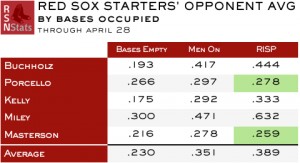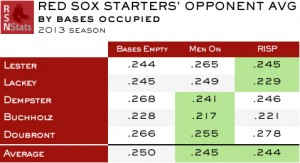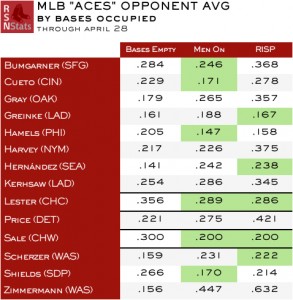The Red Sox make their first West Coast trip starting Monday against the Oakland Athletics before heading up to meet up with the Seattle Mariners.
In the Athletics the Sox will face a team that started the day Monday with the worst record in the American League, 12-21 (.364). Oakland has lost their last 5 games. They’re 3-7 for their last 10, 6-14 for their last 20. They’re 4-9 at home.
In short, Oakland should represent an opportunity for some Red Sox wins if it weren’t that the two clubs are so closely matched.
It’s not that the Athletics aren’t scoring runs. Their 153 runs scored is 3rd-most in the AL behind the Blue Jays (172) and Royals (156), and significantly better than the Red Sox’ 135.
It’s just that Oakland pitchers are giving up a lot of runs, too, allowing 156 so far this season, the most of any club in the AL except for the Boston Red Sox pitchers, who’ve allowed 161.
The Red Sox are likewise 3-7 for their last 10 games and a marginally better 7-13 for their last 20. On the road Boston has gone 7-8 thus far. Despite a recent flash of power, for the last 7 days, Boston’s offense has accumulated just 12 runs with 6 of them coming Sunday.
Last year Oakland edged the Sox in their 7-game season series, 4-3. The clubs split the 2013 set, 3-3.
The 2015 series opens with a matchup between Boston pitching bright spot Rick Porcello (3-2, 4.38 ERA) facing Oakland’s Scott Kazmir (2-1, 2.75 ERA).
Kazmir had two wins out of the shoot this season but has since gone winless with 3 no-decisions and a loss in his last game vs the Twins on May 6th. In that game he allowed a season-high 6 earned runs over just 6.0 innings of work. Dustin Pedroia is a career .468 hitter vs Kazmir, having gone 22-for-47 with 4 home runs.
Over their careers Athletics Billy Butler and Coco Crisp have both hit Porcello well at 17-for-49 (.347) and 6-for-20 (.300), respectively.
After these 3 games the Red Sox and Athletics will meet up once again this season, in Boston, on June 5-7.
 In this table the opponent’s AVG is shaded in green when it is either at or below the opponent average in the less tense situation. For example, if the opponent batting average is lower when men are on base than when the bases are empty, it is shaded in green. As you can see, there are no such situations currently with the Red Sox. Similarly, if the opponent batting average is lower with RISP than just when men are on base, it’s shaded in green. That’s the case for both
In this table the opponent’s AVG is shaded in green when it is either at or below the opponent average in the less tense situation. For example, if the opponent batting average is lower when men are on base than when the bases are empty, it is shaded in green. As you can see, there are no such situations currently with the Red Sox. Similarly, if the opponent batting average is lower with RISP than just when men are on base, it’s shaded in green. That’s the case for both  For sake of comparison, let’s view that against the pitching performance of the 2013 Championship season, where opponents’ batting averages were .250, .245, and .244 respectively.
For sake of comparison, let’s view that against the pitching performance of the 2013 Championship season, where opponents’ batting averages were .250, .245, and .244 respectively. As the analysis indicates, for 6 of the 14 “aces,” opponent batting averages stay the same or go down with the bases occupied, in some cases dramatically so. Take, for instance the White Sox’
As the analysis indicates, for 6 of the 14 “aces,” opponent batting averages stay the same or go down with the bases occupied, in some cases dramatically so. Take, for instance the White Sox’ 